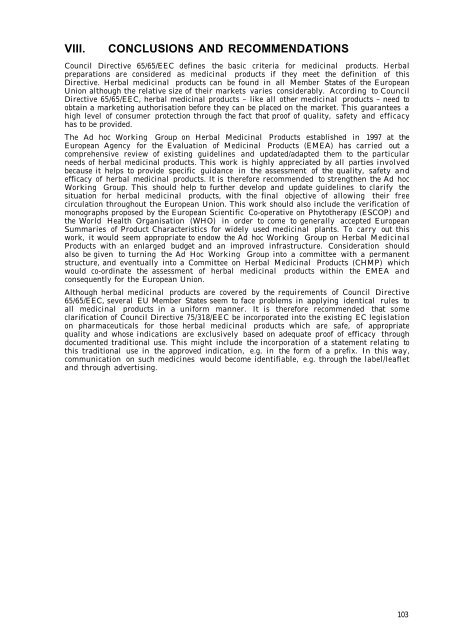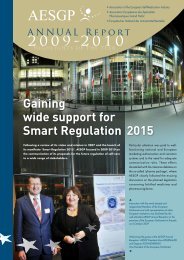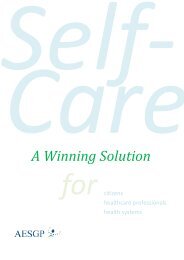Herbal medicinal products in the European Union - AESGP
Herbal medicinal products in the European Union - AESGP
Herbal medicinal products in the European Union - AESGP
Create successful ePaper yourself
Turn your PDF publications into a flip-book with our unique Google optimized e-Paper software.
VIII. CONCLUSIONS AND RECOMMENDATIONS<br />
Council Directive 65/65/EEC def<strong>in</strong>es <strong>the</strong> basic criteria for <strong>medic<strong>in</strong>al</strong> <strong>products</strong>. <strong>Herbal</strong><br />
preparations are considered as <strong>medic<strong>in</strong>al</strong> <strong>products</strong> if <strong>the</strong>y meet <strong>the</strong> def<strong>in</strong>ition of this<br />
Directive. <strong>Herbal</strong> <strong>medic<strong>in</strong>al</strong> <strong>products</strong> can be found <strong>in</strong> all Member States of <strong>the</strong> <strong>European</strong><br />
<strong>Union</strong> although <strong>the</strong> relative size of <strong>the</strong>ir markets varies considerably. Accord<strong>in</strong>g to Council<br />
Directive 65/65/EEC, herbal <strong>medic<strong>in</strong>al</strong> <strong>products</strong> – like all o<strong>the</strong>r <strong>medic<strong>in</strong>al</strong> <strong>products</strong> – need to<br />
obta<strong>in</strong> a market<strong>in</strong>g authorisation before <strong>the</strong>y can be placed on <strong>the</strong> market. This guarantees a<br />
high level of consumer protection through <strong>the</strong> fact that proof of quality, safety and efficacy<br />
has to be provided.<br />
The Ad hoc Work<strong>in</strong>g Group on <strong>Herbal</strong> Medic<strong>in</strong>al Products established <strong>in</strong> 1997 at <strong>the</strong><br />
<strong>European</strong> Agency for <strong>the</strong> Evaluation of Medic<strong>in</strong>al Products (EMEA) has carried out a<br />
comprehensive review of exist<strong>in</strong>g guidel<strong>in</strong>es and updated/adapted <strong>the</strong>m to <strong>the</strong> particular<br />
needs of herbal <strong>medic<strong>in</strong>al</strong> <strong>products</strong>. This work is highly appreciated by all parties <strong>in</strong>volved<br />
because it helps to provide specific guidance <strong>in</strong> <strong>the</strong> assessment of <strong>the</strong> quality, safety and<br />
efficacy of herbal <strong>medic<strong>in</strong>al</strong> <strong>products</strong>. It is <strong>the</strong>refore recommended to streng<strong>the</strong>n <strong>the</strong> Ad hoc<br />
Work<strong>in</strong>g Group. This should help to fur<strong>the</strong>r develop and update guidel<strong>in</strong>es to clarify <strong>the</strong><br />
situation for herbal <strong>medic<strong>in</strong>al</strong> <strong>products</strong>, with <strong>the</strong> f<strong>in</strong>al objective of allow<strong>in</strong>g <strong>the</strong>ir free<br />
circulation throughout <strong>the</strong> <strong>European</strong> <strong>Union</strong>. This work should also <strong>in</strong>clude <strong>the</strong> verification of<br />
monographs proposed by <strong>the</strong> <strong>European</strong> Scientific Co-operative on Phyto<strong>the</strong>rapy (ESCOP) and<br />
<strong>the</strong> World Health Organisation (WHO) <strong>in</strong> order to come to generally accepted <strong>European</strong><br />
Summaries of Product Characteristics for widely used <strong>medic<strong>in</strong>al</strong> plants. To carry out this<br />
work, it would seem appropriate to endow <strong>the</strong> Ad hoc Work<strong>in</strong>g Group on <strong>Herbal</strong> Medic<strong>in</strong>al<br />
Products with an enlarged budget and an improved <strong>in</strong>frastructure. Consideration should<br />
also be given to turn<strong>in</strong>g <strong>the</strong> Ad Hoc Work<strong>in</strong>g Group <strong>in</strong>to a committee with a permanent<br />
structure, and eventually <strong>in</strong>to a Committee on <strong>Herbal</strong> Medic<strong>in</strong>al Products (CHMP) which<br />
would co-ord<strong>in</strong>ate <strong>the</strong> assessment of herbal <strong>medic<strong>in</strong>al</strong> <strong>products</strong> with<strong>in</strong> <strong>the</strong> EMEA and<br />
consequently for <strong>the</strong> <strong>European</strong> <strong>Union</strong>.<br />
Although herbal <strong>medic<strong>in</strong>al</strong> <strong>products</strong> are covered by <strong>the</strong> requirements of Council Directive<br />
65/65/EEC, several EU Member States seem to face problems <strong>in</strong> apply<strong>in</strong>g identical rules to<br />
all <strong>medic<strong>in</strong>al</strong> <strong>products</strong> <strong>in</strong> a uniform manner. It is <strong>the</strong>refore recommended that some<br />
clarification of Council Directive 75/318/EEC be <strong>in</strong>corporated <strong>in</strong>to <strong>the</strong> exist<strong>in</strong>g EC legislation<br />
on pharmaceuticals for those herbal <strong>medic<strong>in</strong>al</strong> <strong>products</strong> which are safe, of appropriate<br />
quality and whose <strong>in</strong>dications are exclusively based on adequate proof of efficacy through<br />
documented traditional use. This might <strong>in</strong>clude <strong>the</strong> <strong>in</strong>corporation of a statement relat<strong>in</strong>g to<br />
this traditional use <strong>in</strong> <strong>the</strong> approved <strong>in</strong>dication, e.g. <strong>in</strong> <strong>the</strong> form of a prefix. In this way,<br />
communication on such medic<strong>in</strong>es would become identifiable, e.g. through <strong>the</strong> label/leaflet<br />
and through advertis<strong>in</strong>g.<br />
103




